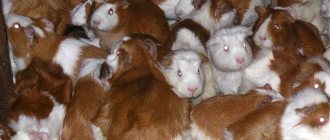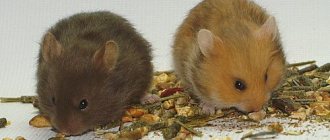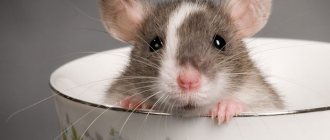Toy terriers are one of the dog breeds that are considered puppies, even if the dog is already an adult. Small, smooth-haired dogs have fascinated, above all, women all over the world.
A toy terrier can be carried in a bag (it is important to remember that the bag for carrying a pet must be designed for this purpose) to various events, or taken with you on a visit or to a cafe. Babies love the attention of their owners more than anything else in life and are happy to be near them all the time.
The popularity of the breed in the world is great, but small dogs require an even more responsible approach on the part of the owner. Improper feeding can lead to problems with the stomach and intestines. Toy terriers do not complain about their health if they follow the correct diet and walk in clothes in the cold season.
Advice! If an adult dog looks like a puppy, then you cannot feed it based on the number of feedings of puppies. An adult Toy Terrier should eat 2 times a day, like any breed of dog.
Despite its size and fragile build,
the basis of the diet for this breed is meat .
Toy Terriers are incredibly active dogs that expend enormous amounts of energy throughout the day, making them constantly ready to eat more. But you should not overfeed your pet, as obesity will sharply reduce life expectancy. It is important to balance food in terms of protein, carbohydrates and fats.
Important! Meat in the diet of a small predator should be from 40 to 50%, cereals (cereals) - from 20 to 30%, vegetables - 15-25%, fruits - 2-5%.
The standard for toy terriers appeared at the end of the 20th century, according to which the dog’s weight does not exceed 3 kg, and its height reaches 20–28 cm . If the dog is shorter than the declared height, then its weight should not exceed 1.5–2 kg. Portions for adult pets are weighed on an electronic kitchen scale, which will be very helpful in determining the weight of a portion. For every kilogram of animal weight there should be 65–80 grams of food.
Feeding dry food
convenient and simple; “drying” will not deteriorate and will not “infect” your pet with helminths and infections. But even in this case, remember the rules:
- provide your dog with access to fresh water at any time of the day;
- follow the portion size and frequency of feeding indicated on the package;
- do not delay feeding so that there is no “hungry vomiting” in the morning and stomach overload in the evening;
- do not mix “drying” and “natural” in one bowl;
- Don't change brands unnecessarily.
Of the two feeding methods - portioned and buffet - the first is suitable for toy terriers, as they are prone to overeating. The daily amount of cheap food is ~ 300-400 g for a small dog, expensive food is ~ 30-185 g, since its nutritional value is higher. The serving size depends on the activity of the pet and its current weight.
How to choose dry food
Toy is sensitive to the structure and composition of food, so choose a manufacturer and brand of food in the “premium” range and above. The packaging should indicate that the food is intended for small breed dogs or specifically for toy terriers.
Look at the composition: meat and meat products should come first (indicating the type of animal or poultry). The food should not contain corn (causes allergies).
Economy class food
They consist of wheat, soybeans, corn and a small amount of meat and bone and fish meal, low quality by-products. All this is “enriched” with flavorings and taste enhancers, which are addictive in dogs. Abundant additions of phosphorus, potassium, and calcium eventually lead to urolithiasis. Economy class feed brands include Chappi, Pedigree, Darling. Replenish the lack of protein, minerals and vitamins with natural nutrition (liver, tripe), but give it at another time.
Premium class
This includes diets containing pure meat (without tails, heads and meat trimmings) up to 25%, in total with high-quality offal - 30%. They do not contain allergenic grains; the source of carbohydrates is rice.
Royal Canin Size Mini Sensible
Designed for small dogs with sensitive digestion. Maintains the balance of intestinal microflora (prebiotics), fights tartar (sodium polyphosphate), regulates the pet’s weight (levocarnitine).
Super Premium class
Characterized by the content of at least 25% pure meat, by-products are allowed in equal proportions, but only healthy ones (liver, heart).
1st Choice Adult Toy&Small Breeds Health
Protein is represented by lamb meal and white fish, carbohydrates - rice, potatoes, barley and oatmeal. Suitable for toy terriers prone to allergies and digestive disorders.
Holistics
The most expensive dry food. The main component is meat (50-80%), does not contain by-products. It is believed that unusual combinations of components (fruits, vegetables, berries, herbs) fully meet the dogs’ need for nutrients and biologically active substances.
Acana Adult Small Breed Heritage
Chicken meat, eggs, flounder meat (60%), vegetables, fruits, berries (40%) were used. Protein is energy that small dogs need just as much as large ones. No grain or potatoes.
How to change your dog's food?
If for some reason the old food is no longer suitable, replace it with another. The transition from natural food to dry food is the most difficult for Toys. To minimize it, remember the rules:
- transfer the dog to a different diet gradually, over 12-14 days;
- do not skimp on new food: it is better to buy an expensive one, but then not have problems with health and addiction;
- do not buy a lot of new food at once, take a one-time or trial portion, see how the dog reacts to it;
- increase the amount of water if your pet switches to a dry diet.
Reviews from veterinarians
70% of pathologies in dogs develop due to errors in feeding (poisoning, internal and external non-contagious, parasitic and even some infectious diseases). Dry food seems to be safer for pets' health.
Doctors recommend using complete food of various premium and higher class lines to control weight, allergies, some pathologies that have already developed in dogs, to make it easier for them to age, and to provide them with the necessary nutrients during whelping and lactation.
Another opinion is that it is easier, and most importantly, cheaper, for small breed dogs to prepare “natural” food, since the price of high-quality dry diets is formed not only from the cost of the components, but also from the payment of experts, clinical trials, preparation and packaging technologies.
Veterinarians do not recommend food that contains corn (and other grains) in the first place, contains preservatives, dyes, odor imitators - among them there are drugs and carcinogens.
Photo: pixabay.com
Veterinarian advice
Everyone has a fear of giving their pet a product of inferior quality. In order not to harm the toy terrier, it is advisable to choose food from a trusted manufacturer with a high content of animal proteins. Well-known brands, especially the premium segment, do not use meat waste - horns, skins, hooves.
Whatever the type of food for a toy terrier, you should not limit its drinking. Water should always be available to your pet. This is especially important when eating dry food. It is better to choose Holistic type food; they contain a sufficient amount of meat products, cereals, and vitamin and mineral supplements.
Dogs are prohibited from giving watermelon, grapes, and pasta.
To see the joyful eyes of a dog every day, it is enough to adhere to the basic rules in organizing his life.
A Toy Terrier should always have:
- in a bowl there is clean water, fresh food;
- The diet includes vitamin and mineral complexes.
When choosing between dry food and preparing food at home, in natural conditions, it is better to rely on your own strengths, because the pet’s development will depend only on the owner.
A dog always brings pleasant emotions to its owner. By following the tips for organizing proper nutrition, you can raise a healthy toy terrier without problems with the gastrointestinal tract.
Natural nutrition
- Balance your dog’s diet in terms of proteins, fiber, vitamins and minerals - this is the main difficulty of eating “natural” food.
- Refrain from feeding your toy from your table; teach her proper manners as a puppy.
- Small dogs easily gain excess weight. Do not overfeed the dog (no more than 50-80 g/kg), take an active walk with it, thirty minutes after eating.
- Cook separately for your pet only from approved foods.
Here is an example of natural nutrition.
Useful video
Here you can find out a lot of interesting information about the Russian Toy Terrier. The video provides advice regarding small pets.
Vitamin supplements
Dogs on premium, super premium and holistic food classes are not required. For the rest, it is necessary to fortify the diet, especially in spring and autumn. There are ready-made multivitamin-mineral complexes:
- for wool (group B, H, fatty and amino acids) - Yumega Boost;
- for joints (D, E, glucosamine, chitosan, probiotics) - “8in1” Glucosamine;
- for small breeds (group B, A, H, Omega3) - Vita Bon,
- for puppies (A, C, E, D, group B, F, minerals) - “8in1” Excel,
- for puppies and lactating bitches (D, C, folic acid (B9), Omega3, calcium, iron) - Pro Bio Booster;
- for old dogs (A, B, E, fatty acids, zinc) - Radostin for dogs over 6 years old.
Wolfsblut Gray Peak Small Breed (15 kg)
German quality holistic specialist. The products of this brand include only those components that are easily absorbed by the dog’s body, without causing any digestive problems.
No wheat, oats, corn, starch or gluten. Meat makes up more than half of the food - cod, mackerel, haddock, pheasant, rabbit, trout, salmon, lamb.
https://dog-care.ru/zdorove/pitanie/luchshih-suhih-kormov-dlya-russkogo-toy-terera.html
pros
- Excellent balance of vitamins, minerals, healthy supplements;
- Complete absence of chemical ingredients (flavor and aroma enhancers and dyes);
- Moderate size granules;
- No noticeable odor;
- Elegant, high quality packaging;
- The company has an official website with a detailed description of the product and instructions;
- The condition of the coat improves.
Minuses
- Rarely available in pet stores;
- In isolated cases may cause constipation
Features of feeding puppies
Choose dry food for toy puppies from super premium and holistic classes. You can soak the granules for an hour in warm water (for a one-month-old puppy), or you can give them dry.
Do not leave soaked and wet food for more than a day, in summer - more than two hours!
| Age, months | Feeding frequency, once a day |
|
|
| 1-2 | 6 |
| 2-3 | 5 |
| 3-4 | 4 |
| 4-10 | 3 |
| 10-18 | 2 or 1 (individually) |
Increase the energy value of your baby’s diet with protein, not fat, as their pancreas cannot cope with it.
| Age, months | What to feed |
| up to 1 | mother's milk; complementary foods (dry food or fermented milk, milk, semi-liquid cereals) - from 3 weeks, when the first teeth appear |
| 1-2 | One-and-a-half-month-olds are separated from the bitch, fed finely chopped or soft food, pure milk is removed from complementary foods and replaced with meat |
| 2-3 | feeding is the same, but less often, larger portions |
| 3-4 | increase the amount of vegetables, first stewed, then raw, a little milk |
| 4-10 | more fish; From 5 months, meat can be scalded rather than boiled |
| 10-18 | the dishes are the same, but the portions are larger |
Menu for the week
Recipes for a puppy up to two months of age.
| Day of the week | Diet by hour |
| Monday |
|
| Tuesday |
|
| Wednesday | Like Monday |
| Thursday | Like Tuesday |
| Friday |
|
| Saturday |
|
| Sunday | Like Friday |
Menu for a toy terrier for a week
Monday: Morning - beef (cut into small pieces, or make minced meat) + rice; Lunch - homemade cottage cheese (you can add honey or egg yolk, or wheat germ oil); Evening – sea fish (salmon, pollock, etc.) + grated carrots.
Tuesday: Morning – beef + oatmeal; Lunch – kefir or fermented baked milk; Evening – sea fish + seaweed (clean);
Wednesday: Morning – beef liver + buckwheat; Lunch – boiled beets + carrots + zucchini; Evening – sea fish + sauerkraut.
Thursday: Morning – beef + rice; Lunch – homemade cottage cheese; Evening – sea fish + grated carrots.
Friday: Morning – beef + oatmeal; Lunch – kefir or fermented baked milk; Evening – sea fish + seaweed.
Saturday: Morning – beef liver + buckwheat; Lunch – vegetables; Evening – sea fish + sauerkraut.
Sunday: Morning – beef + rice; Lunch – homemade cottage cheese; Evening – sea fish + herbs (parsley, dill).
From the above products, you can create a menu for puppies, adding the number of feedings per day from fermented milk products. The fact is that when babies grow, they need calcium for the skeletal system, and of course protein.
Feeding a pregnant dog
In the first half of pregnancy (first month), increase the nutritional value of the food using easily digestible protein (fermented milk products and fish), rather than fat. Leave the amount of feed the same. Switch the dry diet to the “puppy” diet. Offer your dog vegetables and fermented milk. The bitch's taste preferences may change.
The second month of pregnancy means a constantly hungry dog. Don't overfeed! It will be more difficult for an obese bitch to give birth. Increase not the serving size, but the quantity: from week 5, feed 3 times a day, from week 6 - 4-5. Before giving birth (7 days before), you need to gradually reduce the amount of protein in your diet; for the last 2-3 days, do not give fish or meat at all.
Early toxicosis, refusal to eat (up to 4 weeks) for up to 7 days is not dangerous. Late toxicosis (5-6 weeks) - complete refusal to eat for up to 3 days - show it to your veterinarian; If the toy eats, but little, and receives vitamins, postpone the visit to the veterinarian for another 5 days.
If the bitch ate the placenta after giving birth, feed her after 5 hours; if not, offer food immediately. It is important to give the birthing mother water, milk, and cream.
For the first ten days, give protein in the form of cottage cheese and eggs, after that you can eat meat and offal. Feed the toy mother to her fullest in small portions 6-7 times a day, gradually increasing the amount over the course of a month, then decreasing the same amount.
Photo;wikimedia.org
Prohibited Products
Foods that should not be given to dogs:
- raw sausage, eggs and fish;
- spices and seasonings;
- pork;
- sour cream and cream;
- legumes;
- fatty broths;
- mayonnaise and ketchup.
If your pet has eaten a product from the prohibited list, then if his health worsens, it is better to call a veterinarian. The body’s reaction manifests itself depending on the dog’s degree of endurance and its overall health.
Eating problems
An adult toy terrier's refusal to feed is a signal to the owner to pay attention to his health. Why does he refuse food?
- food allergies - cancel the new food;
- abdominal pain, gastritis - show it to your veterinarian, follow the prescribed diet;
- attempts to be capricious - do not give in, buy the dog a new bowl;
- pregnancy, toxicosis - find out the dog’s preferences, do not force feed;
- stale, hot, cold food - give quality food;
- teeth hurt, ear inflammation, poisoning, fever - show it to the vet;
- undergoing a course of medication - consult your doctor;
- postoperative period - feeding in small “light” portions;
- worms - treat for parasites;
- anxiety, depression, changes in usual lifestyle - protect from stress.
Acana Heritage (6 kg) (for small breeds)
This Canadian product is a good choice for a miniature breed dog. It is suitable for both active animals and completely lazy ones. The food is holistic, that is, it contains only natural ingredients.
There are no cheap low-quality components in the products of this brand; feed wheat and bone meal are completely absent. Contains only meat, fish, vegetables, fruits, and high quality dairy products.
pros
- High concentration of animal proteins;
- Fresh ingredients;
- There are no carbohydrates (the dog’s body does not need them);
- A variety of fruits, vegetables, tonic herbs in the composition, which strengthen the heart and improve the condition of the gastrointestinal tract;
- Reduces insulin levels, strengthens the liver;
- High quality packaging.
Minuses
- May cause allergies;
- Noticeable fishy smell;
- High fat content.
What you can and cannot feed
Authorized products:
- lean meat and chicken by-products - 15-30%;
- sea fish - sometimes replace meat;
- fermented milk products (cottage cheese, kefir, bifidok) - 1 time every 3 days;
- porridge (rice, buckwheat, rolled oats) - 30-35%;
- eggs - once a week;
- vegetables - 20-25%;
- fruits - sometimes, in small pieces.
Forbidden:
- fatty food,
- sweet, salt, salty, hot, spicy,
- preservatives,
- flour pastry, pasta,
- nuts,
- bones,
- milk.
Photo: pixabay.com
Some recommendations from personal experience
1. Meat, fish, cottage cheese can and should even be frozen in portions. This way, it will be convenient for you to always keep the necessary products at hand, and also rid them of bacteria.
2. Porridge can be lightly salted, using sea salt.
3. I buy fortified children’s kefir for my baby and recommend it to you.
4. You can find low-fat cottage cheese, but it will not be homemade. I preferred homemade, even if it was greasy. It's healthier than store-bought. I give it a little at a time so that the fat content doesn’t hit the baby’s liver.
5. Feeding your dog beets is very healthy. Don't be scared when you see her peeing burgundy urine. This is fine.
6. Do not increase portions more than necessary.
7. Many experts recommend giving dogs vitamins. My dog grew up in excellent strong shape even without them. You can try treating yours with vitamins. But, it is better not to accustom her body to ready-made artificial vitamins, let her suck them out of natural products. That's why we feed them.
Feeding, no matter how correct, will not save your dog from diseases or allergies if you initially bought a puppy prone to diseases. Do not buy dogs at low prices, be sure to analyze the health status of their parents, and also check all the necessary documents that are provided to you along with the puppy.
What's not allowed?
In general, all representatives of the Toy Terrier breed are prohibited from eating any food from the master’s table.
Since food prepared for humans contains an excessive amount of salt and sugar, which is extremely harmful for the pet.
The list of products, the consumption of which can lead to serious consequences for the toy terrier’s body, is as follows::
- any smoked meats, sausages, frankfurters;
- grilled meat;
- crackers, chips, baked goods;
- chocolate, sweets;
- pasta;
- fatty meat, incl. pork;
- raw offal and raw fish;
- potatoes and legumes;
- raw eggs;
- cream, sour cream;
- spices.











